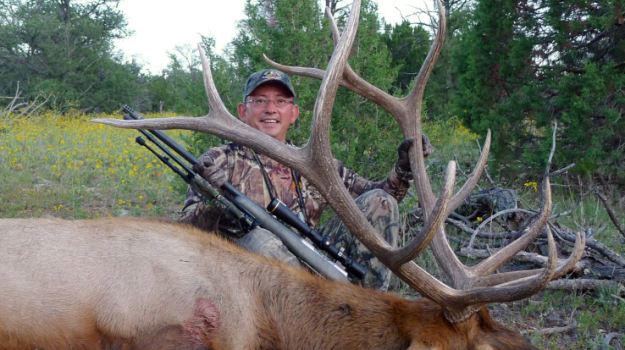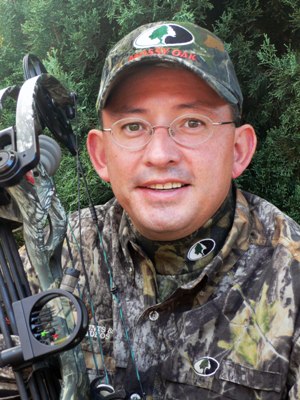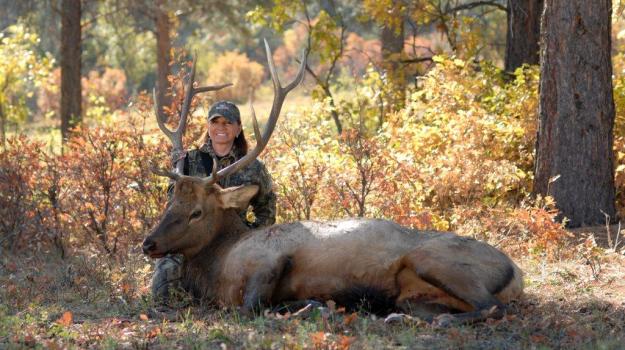The Bad News and the Good News for Elk Hunting in 2014

Editor’s Note: Ralph Ramos of Las Cruces, New Mexico, guides elk hunters in New Mexico, as well as teaches seminars on how to call elk. He’s been guiding elk hunters for more than 20 years, mainly in the Gila National Forest and the Lincoln National Forest. He’s been wearing Mossy Oak camouflage for 25 years, and his favorite pattern is Infinity. “This pattern has a lot of brown in it and blends in really well with the foliage and terrain where I hunt,” Ramos says. “I’ve been shooting PSE bows for 15 years. I’d been on several elk hunts with Pete Shepley the creator of PSE, and Pete introduced me to the people at Mossy Oak. Then I met Tim Anderson of Mossy Oak at one of the Rocky Mountain Elk Foundation (RMEF) national conventions in Reno, Nevada, when he attended my elk seminar. Since then, I’ve been an official Mossy Oak Pro. But I was wearing Mossy Oak long before I met Tim.
The bad news is all the drawings for elk tags in New Mexico are closed for the 2014 season. However, San Francisco River Outfitters www.huntinginnewmexico.com, the outfitter that I guide for, puts in for tags each year for New Mexico. So, this group may have some tags left. If you don’t draw a New Mexico elk tag, you still have a chance to purchase a private-land license. They’re a little pricier than drawing a tag in the public drawing. If you want to hunt elk this year in New Mexico, you can contact San Francisco River Outfitters, and they will search all the databases to try to find you a private landowner tag, which usually sell for between $4,000 - $6,000, depending on the hunting unit of the tag. These tags allow you to hunt the entire unit - not just the landowner’s property. You also have access to the land of the ranch owner who’s sold you the tag. These landowner tags are used as an incentive for the landowners to help protect the elk on their property.
 Also, since elk damage croplands, especially during the winter, the revenue from these landowner tags helps reimburse the landowner for the damage that the elk cause to his crops. As of this writing at the first of May, 2014, some landowner elk tags still are available for this hunting season. You can go on the New Mexico Game and Fish Department’s website and see a list of the landowners and the tags they have available. On this page, there’s a list of every rancher in the state with landowner authorization tags, and you’ll see the phone number of the landowner. So, you can talk with him directly. If you don’t want to do the search yourself, the outfitters can search for you. Tom Klumker is the owner of San Francisco River Outfitters, his phone number is 575-539-2517, or you can go to www.huntinginnewmexico.com.
Also, since elk damage croplands, especially during the winter, the revenue from these landowner tags helps reimburse the landowner for the damage that the elk cause to his crops. As of this writing at the first of May, 2014, some landowner elk tags still are available for this hunting season. You can go on the New Mexico Game and Fish Department’s website and see a list of the landowners and the tags they have available. On this page, there’s a list of every rancher in the state with landowner authorization tags, and you’ll see the phone number of the landowner. So, you can talk with him directly. If you don’t want to do the search yourself, the outfitters can search for you. Tom Klumker is the owner of San Francisco River Outfitters, his phone number is 575-539-2517, or you can go to www.huntinginnewmexico.com.
You also can go to my photos and videos on Facebook at https://www.facebook.com/pages/Ramos-Hunts-Video-Productions/387405144655063. There you’ll see the kind of hunts I guide. Elk season in New Mexico opens September 1, a date that’s right around the corner, if you’re thinking about elk hunting this year.
If you draw a tag for elk in New Mexico, here’s my suggestion on what you should do to get ready for the hunt. First, I recommend that all elk hunters go to their family physicians and get thorough physicals. Let your doctor suggest a training regimen to get you in the best physical shape possible before the hunt. An elk hunt is a very-physical type hunt. The better you’re prepared physically; the greater your odds will be for having a successful hunt. On these hunts, we wake up at 4:00 am, have a quick breakfast and pack a lunch, so we can stay out all day. Then we ride 4-wheelers to an area I’ve pre-scouted. While still dark, we’ll get off the 4-wheelers and try to locate elk that are in riparian zones (wet, marshy, water areas) in the bottoms of draws and canyons - where elk go to at night to breed.
We’ll hunt off high ridges and bugle down into the canyons, to try to locate the elk and then call them to within gun or bow range. I’ll use bugling, excessive cow calling and rattling sounds to simulate a fight between two bulls. While I’m rattling, I’ll give some moans, growls and chuckles to make the fight sound authentic - a really-exciting technique. When we call in a bull using these aggressive type calls, he’ll come in with hurt on his mind. Within the first 30 minutes of light, the elk will be leaving the canyons and heading out toward the high country, where they normally bed. By 9:15 to 9:30 am, the elk usually are bedded down. We try and take them when they’re in the canyons, when they’re moving to their bedding areas, or once they’re already in their beds.
Ralph Ramos Explains His X Factor Style of Calling to Put a Bull Elk in His Hunter’s Lap




























